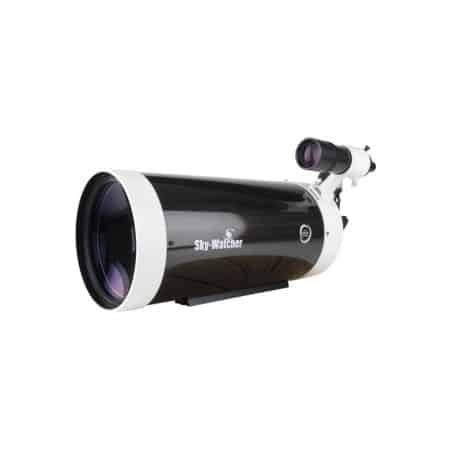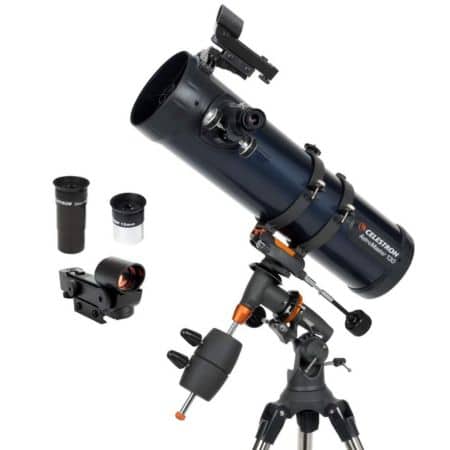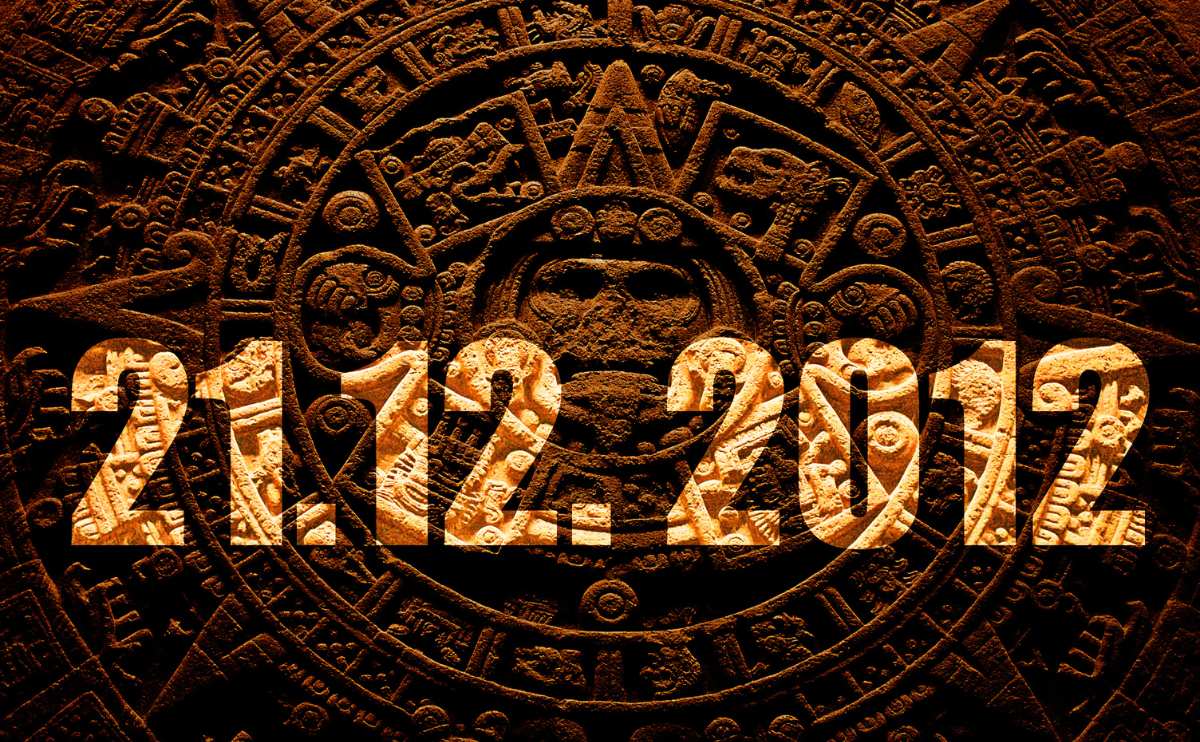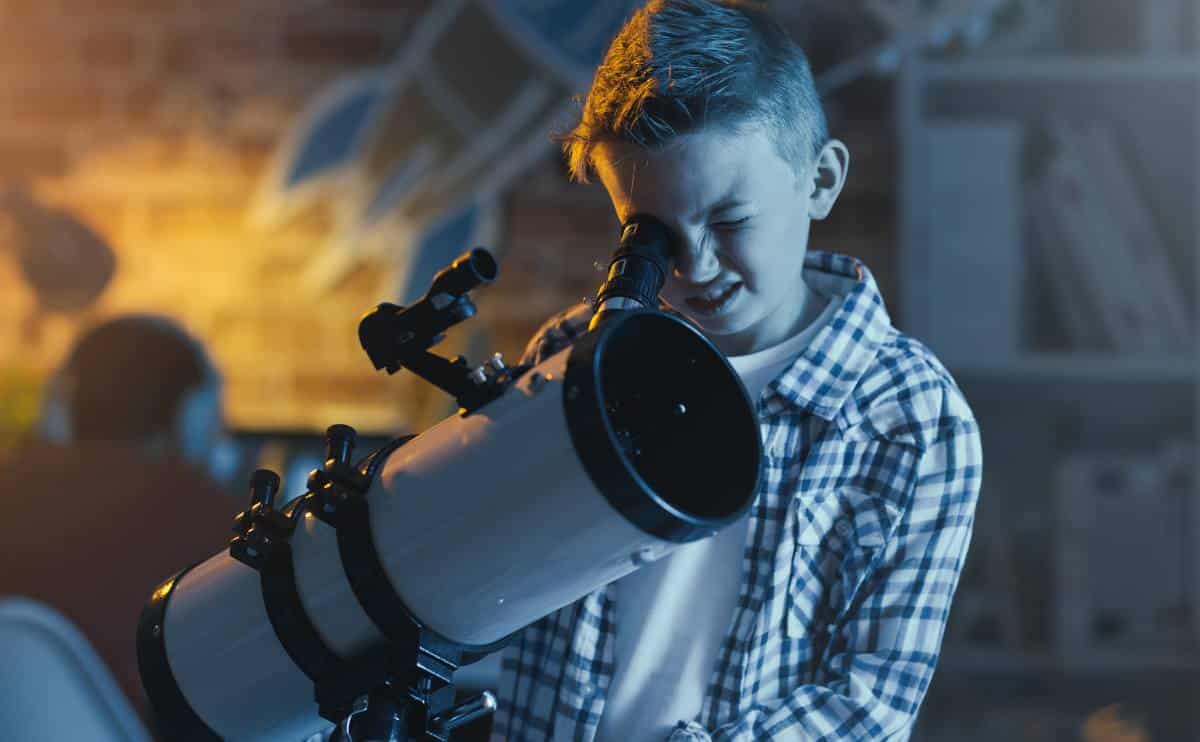Best Telescopes For Viewing Planets And Galaxies: Celestron vs Sky-Watcher
When you purchase through links on our site, we may earn a commission. Here’s how it works.
If, like me, you are always looking up at the night sky to catch a glimpse of stars, planets, comets, or other celestial marvels, consider using a telescope to increase the depth and clarity of your celestial views. Telescopes are made with the sole purpose of enhancing what we can see in the universe. Space is full of amazing things to see. The powerful views from a telescope allow us to see these marvels with our own eyes.
If you aim to get clear views of planets and galaxies, some telescopes can work better than others. I’ve reviewed some of the best telescopes for viewing planets and galaxies and the features of each.
| Overall | Planets | Galaxies | Premium |
|---|---|---|---|
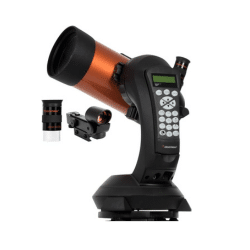 | 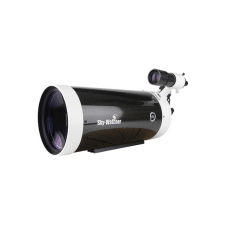 | 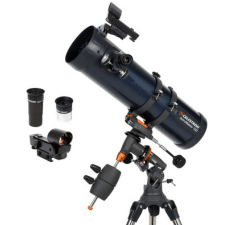 | 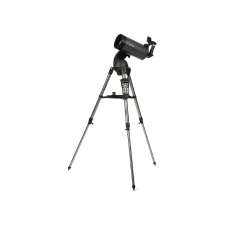 |
| Celestron NexStar 8SE | Sky-Watcher SkyMax | Celestron AstroMaster | Celestron Advanced VX8 |
| View on Amazon | View on Amazon | View on Amazon | View on Amazon |
| Read Review | Read Review | Read Review | Read Review |
How A Telescope Works
Understanding how telescopes work is the first step to starting your planetary visual adventure.
Telescopes use different methods to collect light from objects in space and use this light to create an image we can see in greater detail than with the naked eye. Not all telescopes are built the same, but they allow us to view images from millions of miles away. Pretty cool, right?
Below, I give a basic explanation of how telescopes work and the various parts. If you’re not familiar with some of the terms, jump to my terminology section for helpful definitions.
3 Types Of Telescopes
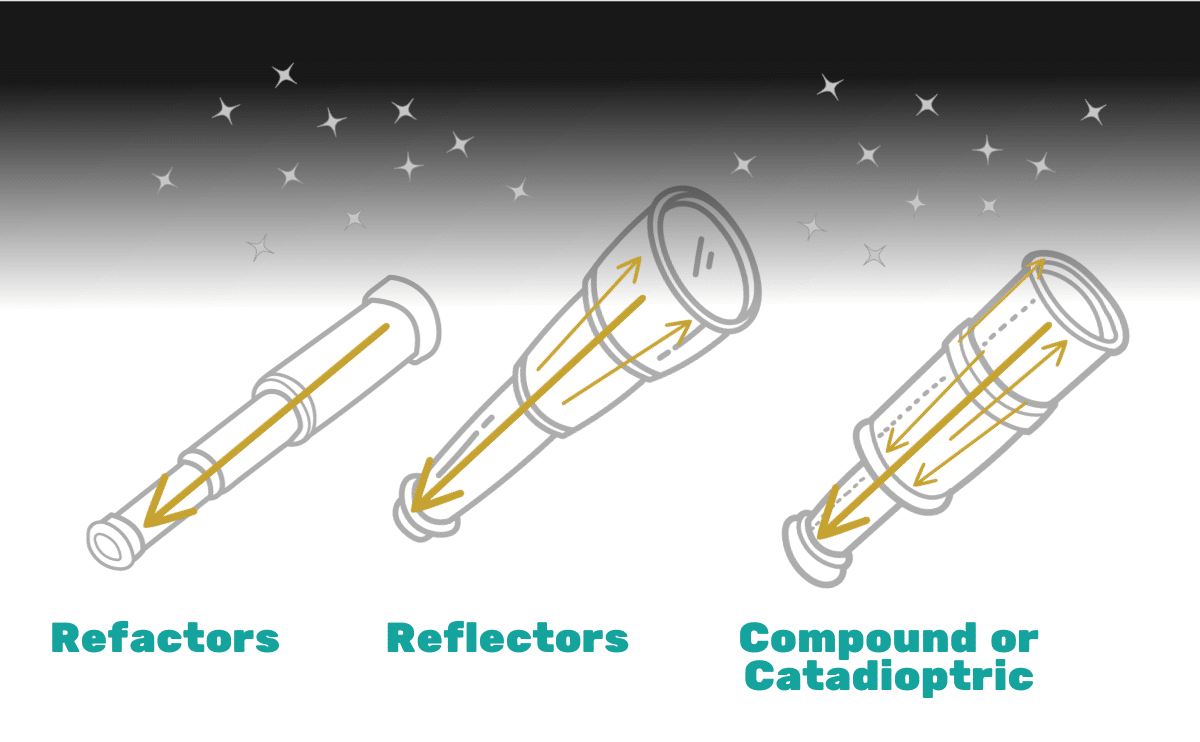
The three main types of telescopes are refractors, reflectors, and compound scopes.
- Refractor – Refractor telescopes use lenses to capture, bend, and focus light. These are the oldest kind of telescope and the kind most people are familiar with. Refractor scopes consist of long tubes and powerful lenses. The most basic refractor scopes use two lenses, but some, called apochromatic refractors, use three. The Yerkes Observatory in Williams Bay, Wisconsin, houses the largest refractor scope used for astronomical research.
- Reflector – Reflector telescopes use mirrors to capture and reflect light. These usually have one or more curved mirrors that work together to reflect a detailed image from far away. The James Webb Space Telescope, for example, is a giant reflector that has been marveling the world with breathtaking images of never-before-seen parts of deep space.
- Compound – Also called catadioptric telescopes, these use a combination of lenses and mirrors to project detailed images.
Telescopes can be fully manual or have electronic components. With fully manual ones, you must adjust the focus by hand. Motorized or computerized telescopes often have built-in features to help find and focus an image. Whether you aim to observe planets and galaxies or take pictures of them, a reflector or compound telescope will provide you with a clear image.

5 Things To Consider Before You Buy
You want a telescope that’s easy to use but will also provide you with high-quality images. Keep in mind that what might work best for you may not be the ideal scope for someone else. It depends on your goal, where you plan to use the telescope, experience, interest, and budget. Take some time to reflect on the following:
- What is your intended purpose or goal? Are you using it for casual observation, or are you interested in astrophotography? If you want to take pictures, you need a larger aperture.
- Where do you plan to use this telescope? This factor is important because some are more portable than others. A larger one may be okay if you want to set it up in one primary spot and not move it often. However, if you are more active and plan to take your scope to explore different places, you’ll want one that’s lighter, more portable, and designed to move easily.
- How complicated a telescope is to set up is also important. Some scopes take a little while to assemble, set up, position, and focus. Others, especially some that are computerized, are easier to set up and require less time to get focused.
- How much room does the telescope occupy during use and when broken down? Ensure you have enough room to safely store the scope without damaging it when not in use.
- What’s your budget? Prices can range into thousands of dollars. The good news is that there are telescopes that fit just about every budget. For a beginner, starting with a less expensive one is an excellent way to dip your toe into the activity without breaking the bank. Spending a little more money might be justified for a committed and experienced skywatcher or astrophotographer.
What Specific Features Are Important To View Planets And Galaxies?
I have researched many different kinds of telescopes to learn what they offer and which ones work better for different purposes. For example, you will want a refractor to search for brighter sky objects, including planets, the moon, star clusters, and double stars. A reflector might be a better pick to look at galaxies and nebulas, which are slightly dimmer. Of course, a compound scope is a great compromise and can allow you to observe various celestial objects.
Another thing to remember is that the more details you want to view and the specific planets or galaxies you wish to view may impact the scope you need. A telescope of at least 50mm to 70mm is necessary to view planetary details like Jupiter’s cloud bands, Saturn’s rings, and other details. That said, a 50mm scope will not be powerful enough for you to make out the details of Mars, though you will see it as a red dot in the image. The more powerful and larger the telescope, the more planetary detail you see.
A refractor telescope with an aperture of 70mm to 100mm and a longer focal length between 1000mm and 1500mm is a good choice for observing planets. To observe galaxies, a reflector with a larger aperture between 150mm to 250mm and a focal length between 750mm and 1250 mm is a good choice to view distant fuzzy objects like galaxies.
Best Telescopes For Viewing Planets And Galaxies
Below, I review some of the top telescopes for viewing planets and galaxies and a few that work for viewing both. One thing you should keep in mind is that if you are interested in viewing galaxies or planets, many of the best ones for this purpose will be larger, heavier, and less portable.
Best Overall Telescope For Viewing Planets & Galaxies: Celestron NexStar 8SE Review
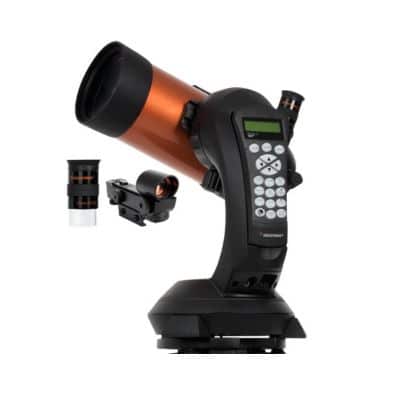
Celestron is a staple in the astronomy industry and makes several fantastic options. One that stands out for a few reasons is the NexStar 8SE, which is a computerized scope. The NexStar 8SE is a wonderful scope for beginners and experienced astronomers alike. One of the things I like the most about this scope is that it’s very user-friendly. The images are also sharp, brightly lit, and fairly detailed.
This scope does have a limited field of view. However, it comes with Sky Align software and a go-to motorized mount, which makes locating celestial and deep space objects much easier. This scope comes with a hand controller with nine different speeds, meaning you can slowly or quickly make precise adjustments and movements for your night sky viewing. It’s mounted on a motorized GoTo mount that automatically locates and tracks sky objects for you. Along with that, purchasing this Celestron gives you access to a database of over 40,000 celestial objects.
The NexStar 8SE has an eight-inch aperture, which picks up plenty of light to observe planets and deep-space objects. Because it’s fully automated, it’s easier to quickly use, break down, and focus on celestial objects.
The NexStar 8SE is a sizable investment; if you want a similar option but want to spend a little less, consider the NexStar 4SE. It is less powerful but retains several motorized and electronic features, making this scope so easy to use. Celestron telescopes come with a two-year or Limited Lifetime Warranty for U.S. and Canadian customers.
Our Personal Experience With The NexStar Telescope Line
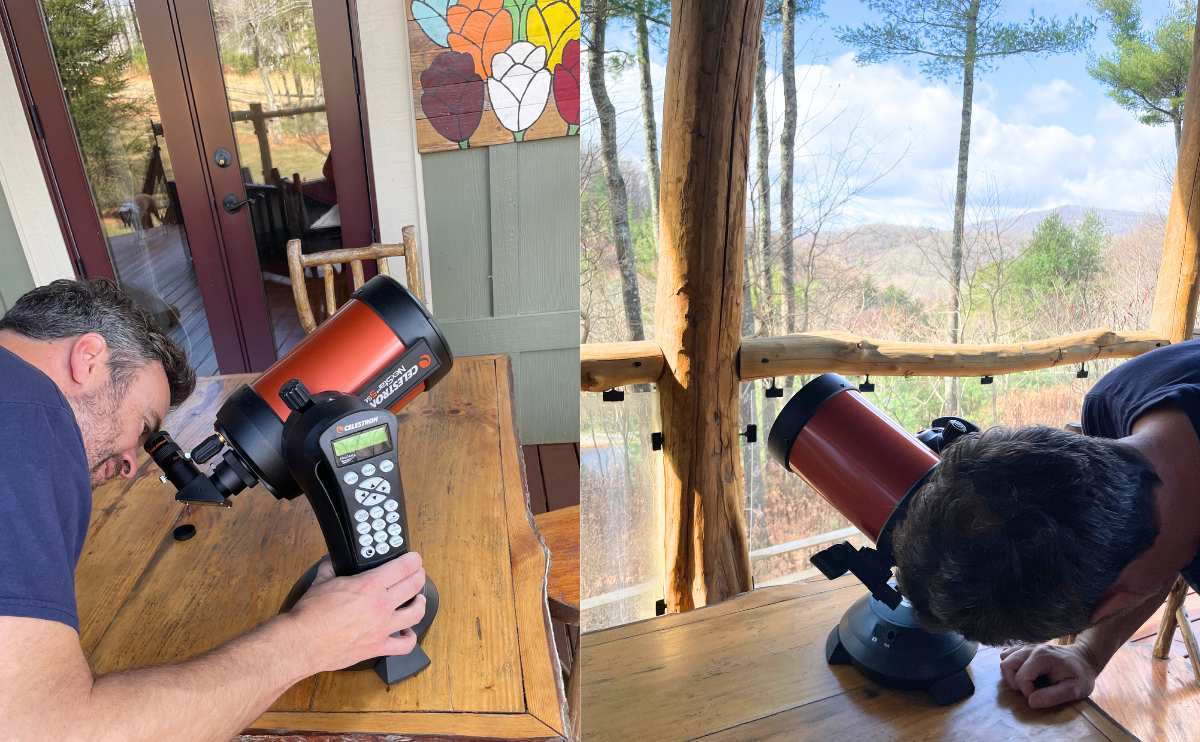
I purchased a NexStar telescope a few years ago. I have been very pleased with the investment. This telescope is very easy to set up and use, and the images it shows are impressive. It is perfect for all ages and skill levels. I have used it with my younger kids and also with older, more experienced astronomers. The included software and star maps are wonderful resources and make it very easy to find celestial sites to observe. The scope is very sturdy and has lasted many years with very few if any, functionality issues or breaks.
Alex Schenker, Star Gazing Amateur And Safe Smart Living CEO
| Pros | Cons |
|---|---|
| Motorized GoTo mount | Requires 8 AA batteries |
| Hand controller | Higher price |
| Sky Align technology | Takes time to learn |
| Comes with a tripod | |
| Can locate and track objects in space | |
| Celestron has a 2-year or limited lifetime warranty for U.S.A. and Canadian customers |
Price & Tech Specs
- $1,599.00
- Dimensions: 16.54″D x 9.31″W x 5.11″H
- Weight: 23.9 pounds (assembled)
- Focal Length: 2032mm
- Focal Ratio: f/10
- Resolution: .69 arc seconds
- Clear Aperture: 203.2mm
Best Telescope For Viewing Planets: Sky-Watcher Skymax 180mm Maksutov-Cassegrain Review
The Sky-Watcher Skymax-180 PRO is a precision scope that packs a lot of power. The longer scope offers greater fine detail. The compound-style reflector is a bit heavier but compact. It also has a larger aperture with a 7.1-inch primary mirror, a longer focal length, and a high-resolution optical system. These features allow you to see vibrant views of planets and space objects.
One thing to remember is that although the Skymax is compact, it’s heavy, so it’s more challenging to move about than others. Additionally, it only comes with one 2-inch/28mm eyepiece. Investing in an 8mm or 10mm eyepiece will enhance the scope’s powerful optics.
The Sky-Watcher SkyMax is a sturdy scope mounted on a strong, heavy-duty equatorial mount. The mount can carry a lot of weight and is beneficial if you’re interested in astrophotography or adding additional equipment to your scope.
| Pros | Cons |
|---|---|
| Large aperture | Only comes with one eyepiece |
| Fully multi-coated | Some users would like more detailed instructions |
| Sturdy scope and mount | May be harder to use for beginners |
| Good for fine details | |
| Longer focal length | |
| Comes with a 2-year limited warranty for U.S.A. customers who have purchased from an authorized dealer |
Price & Tech Specs
- $1,185.75
- Dimensions: 30″D x 12″W x 14″H
- Weight: 19 pounds (assembled)
- Focal Length: 2700mm
- Focal Ratio: f/15
- Resolution: 1.02 arc seconds
- Clear Aperture: 180mm
Best Telescope To See Galaxies: Celestron AstroMaster 114EQ Review
The Celestron AstroMaster 114 EQ is a top pick if you want an affordable scope suitable for beginners and more experienced astronomers. This scope has powerful imaging capability to see planets and galaxies. The AstroMaster 114 EQ is a Newtonian reflector with a 114mm aperture. It can gather enough light to see within our solar system and beyond. Users report being able to see Jupiter’s Galilean moons, the moon’s craters, Saturn’s rings, and more.
The optics are extremely high quality, and this scope is reasonably easy to use. It is sturdy, features fully coated glass optics, and has a full-height tripod, two eyepieces, and a star pointer red dot finderscope. The Astro Master features a manual German Equatorial mount. It’s easy to set up and requires no additional tools.
You also receive a free download of the Starry Night basic edition software, which gives you access to a 36,000 celestial object database, printable sky maps, and interactive sky simulations. The software will help you learn more about stargazing and celestial objects in general. You can even use the software to plan what you want to see next.
| Pros | Cons |
|---|---|
| Affordable | Needs batteries; it may run out of power |
| Sturdy frame | Some users find it hard to maneuver |
| Simple setup | Can be hard to adjust for inexperienced users |
| Fully coated glass optics | |
| Free software download | |
| Larger aperture 114mm to see galaxies and planets | |
| 2-year or limited lifetime warranty for U.S.A. and Canadian customers |
Price & Tech Specs
- $299.00
- Dimensions: 40″D x 32″W x 42″H
- Weight: 19.8 pounds (assembled)
- Focal Length: 1000mm
- Focal Ratio: f/8.77
- Resolution: 1.02 arc seconds
- Clear Aperture: 114mm
Best Premium Telescope For Viewing For Planets & Galaxies: Celestron Advanced VX 8-inch Schmidt-Cassegrain Review
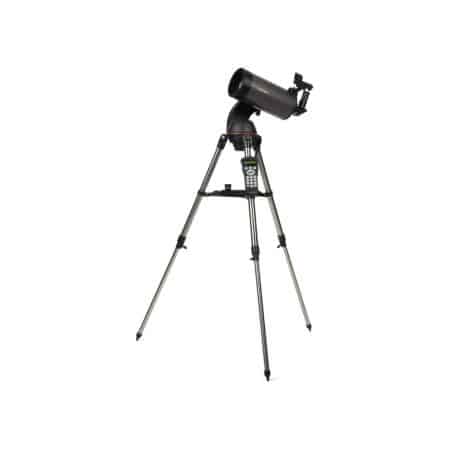
This refractor is a very powerful tool that can help you see galaxies in high detail. The Celestron VX 8 has an amazing light-gathering ability. It is set on a computerized GoTo mount to find and track objects. It has incredible optics, with StarBright XLT coatings providing better light transmission. And it has an 8-inch aperture and can gather 84% more light than a 6-inch.
The Celestron VX is pricier and is intended for more advanced users. It features a computerized hand control and is programable. The high-quality optics allow you to see amazing details of planets and other celestial objects. It’s excellent for backyard viewing and can be easily transported. Though the scope weighs 42 pounds, it has ergonomic handles to make moving easier.
The 40,000-object database and internal GPS help you locate and track objects across the sky. This scope uses a DC power cable so that you can plug it into the car on the go. It doesn’t use batteries, so the power lasts quite a bit longer.
| Pros | Cons |
|---|---|
| Motorized GoTo mount | More expensive |
| 40,000-object database | For more advanced astronomers |
| Internal GPS | Heavy |
| 8-inch aperture | |
| Uses a DC power cable, no batteries | |
| Ergonomic handles for easy movement | |
| 2-year or limited lifetime warranty for U.S.A. and Canadian customers |
Price & Tech Specs
- $2,299.00
- Dimensions: 22″D x 10″W x 11″H
- Weight: 23.9 pounds (assembled)
- Focal Length: 2032mm
- Focal Ratio: f/10
- Resolution: .69 arc seconds
- Clear Aperture: 203.2mm
Important Telescope Terminology
If you are new to skywatching, you can learn more about tools to start with in our beginner telescope guide. We also cover the best scopes for astrophotography if you want to capture some astronomical images.
It is important to understand the basic parts of telescopes, their function, and how to use them. Understanding how they work is vital before you purchase because you want to buy one that is simple enough to use. Below, I cover a few basic terms every skywatcher should know.
- Aperture – The aperture is the diameter of the primary light-gathering mirror or lens. Aperture is most often measured in millimeters, though some manufacturers use inches instead. The higher the aperture, the finer details you can see. You will want a larger aperture if living in a more populated, urban area. A larger aperture is almost always preferable, giving you a more detailed picture. Aperture and magnification are different, though it is easy to confuse these two things.
- Barlow lens – A Barlow lens is a special kind of lens called a diverging lens, which, when combined with other optical components, can double or triple the focal ratio of the system.
- Coated optics – Coated optics refers to an optical system with a magnesium fluoride coding on at least one of the optical surfaces. This coating helps boost the contrast and light transmission.
- Eyepiece – The eyepiece is the part of the telescope you will become the closest to. It is what you look through, and a telescope is absolutely useless without one. Several different eyepiece styles will allow you to observe different image qualities and brightness.
- Finderscope – The finderscope is a miniature telescope that you can use to locate and line up objects you want to focus on.
- Focal length – The focal length refers to the distance in millimeters between the scope’s primary lens or mirror and the spot where the different rays of light connect and focus. Focal length directly impacts how powerful a telescope is.
- Focal ratio – Focal ratio refers to a telescope’s speed and light-gathering capability. This number is found by dividing the focal length by the aperture. The smaller the focal ratio, the lower the magnification or power. A lower focal ratio will give you a wider view with less magnification. A higher focal ratio will give you a more magnified image but a smaller view.
- Focuser – This is a part of the eyepiece that allows you to bring a celestial object into focus so you can see it in greater detail.
- Magnification – Magnification refers to the ratio between an object’s true size and its observed size. Magnification is often used interchangeably with the term power when referring to telescopes.
- Magnitude – Magnitude refers to a celestial object’s brightness. The lower the magnitude, the brighter the object. Magnitude and magnification often get confused, but they are not the same thing.
- Mount – A mount is the apparatus that holds up and supports the scope. The mount is also the mechanism that allows you to move the telescope. These can be manual or computerized. A motorized mount is better for taking pictures of celestial objects, which is called astrophotography.
- Objective – The objective refers to the primary light-gathering mechanism, either a mirror or a lens.
- Resolution – Resolution refers to how much detail a telescope has, also called the resolving power.
Other Ways To Explore
The natural world is nothing short of wonderful. If you, like me, love to get away from it all and immerse yourself in nature, a camping trip with your telescope is a truly refreshing way to see nature and astronomical sights you cannot see from the city. If you want to capture some celestial photographs, I also cover the best telescopes for astrophotography.
What is the most fantastic thing you have seen when skywatching? I’d love to hear about it in the comments.
Why Trust Safe Smart Living?
Danielle is a lifelong skywatcher and amateur astronomer. She has dabbled in visual observing and astrophotography. Her passion for learning new things and exploring the world and universe around her started as a young child and has not wavered. Danielle is a professional researcher and former public school educator who uses her love of learning to help bring useful information to others to help improve their enjoyment of life.

